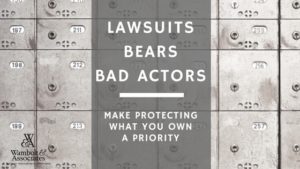Wealth needs to be protected. But in the wealth management arena, the term “asset protection” has different meanings and uses as it shores up capital against various threats. All lead to the same result, though: an asset protection plan that protects your hard-earned capital from bad actors in our litigious society.
While the majority of people might guess that the wealthiest individuals are targeted the most by predatory practices, the truth is that individuals that own between $1 and $5 million and operate in industries often targeted by predators (healthcare professionals, employers, small business owners, artists and entertainers and professional athletes) are at the highest risk of being beset by scammers and nefarious individuals, according to the Asset Protection Council.
Threats to your assets can come in many forms. Here we look at three different ways to safeguard your holdings from market and malicious threats. From the most complicated, offshore trusts, to more day-to-day portfolio and personal information management activities.
Protection from Litigation
The gold standard in safeguarding assets from lawsuits is an offshore trust. When properly structured, these accounts are not subject to U.S. court judgements or court orders, and can offer the tightest level of asset protection, particularly when the following characteristics are folded in:
- Irrevocable – fixed terms, with no provision to undo the trust
- Self-settled – self-created trust, with yourself as the beneficiary
- Spendthrift trust – provisions that limit beneficiary distributions
These assets are further protected by a short statute of limitations and litigation provisions that make them difficult for plaintiffs to pursue prosecution. These include requirements that plaintiffs have to:
- Prove their case beyond a reasonable doubt
- Pay court expenses and fees
- Use non-U.S. attorneys paid for outright, not on a contingency basis
So what’s the downside of an offshore trust? The cost to maintain a foreign trust can be upwards of $10,000 annually, and offshore trusts must be controlled by a foreign trustee. Account owners must also meet strict IRS disclosure requirements, including Forms 3520, 3520A and FATCA & FBAR reporting. Improper disclosure can raise compliance risk, particularly in an era where identifying unreported foreign accounts is a top priority for the IRS.
If these costs seem excessive, there are other litigation-busting tools you can load into your asset protection plan toolbox. Give your advisor a call to find out more.
Protection from Bear Markets
Hedging against market threats is an asset-preservation tool that is as much about timing as it is about selecting the right instruments. While signs point to a continuing bull market in 2018 (see “More Normal than you Think”), the deeper we edge into a mature bull market, the more the bond market might be looking attractive to offset risk in the event we do enter a bear market.
Your portfolio might include a mix of U.S. and International bonds, and the old warhorse, U.S. Treasurys. According to Morningstar data, intermediate-term Treasurys gained as a group during all but one of the 28 bear markets since 1929. And in the one bear market where they didn’t, they still lost less than 1% (WSJ).
Timing an expansion of your bond portfolio to offset equity market risk is an analysis you should undertake with your financial advisor.
Protecting Against Identity Theft
An estimated 17.6 million people, or about 7 percent of U.S. residents age 16 or older, were victims of at least one incident of identity theft in 2014, according to the Bureau of Justice Statistics. This growing problem makes the IRS Dirty Dozen list every year of the most common scams to be aware of in the marketplace.
There is no way to guarantee asset safety against becoming a victim of identity theft. But there are some well-documented best practices you can take to make it more difficult for a scammer to steal your good name.
- Be skeptical when asked for personal information
- Be smart about your activities, such as where you carry your social security card
- Cancel unused credit cards
- Register with one of the Equifax, Experian, or TransUnion for fraud alert notification
- Subscribe to a commercial ID protection service for basic notification
- Add an insurance binder to cover losses in the event of ID theft
Powerful Concepts for Safeguarding Wealth
With as much care and thought that went into building that first million dollars and more, you’ll want to be diligent in safeguarding those assets. A multi-faceted asset protection plan against the various threats mentioned here and others lurking can help shield your assets from unauthorized access. Take steps now to protect what you’ve earned.
Follow Us on LinkedIn
Photo by Samuel Zeller on Unsplash


